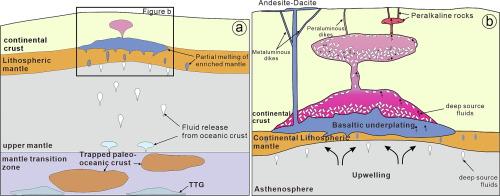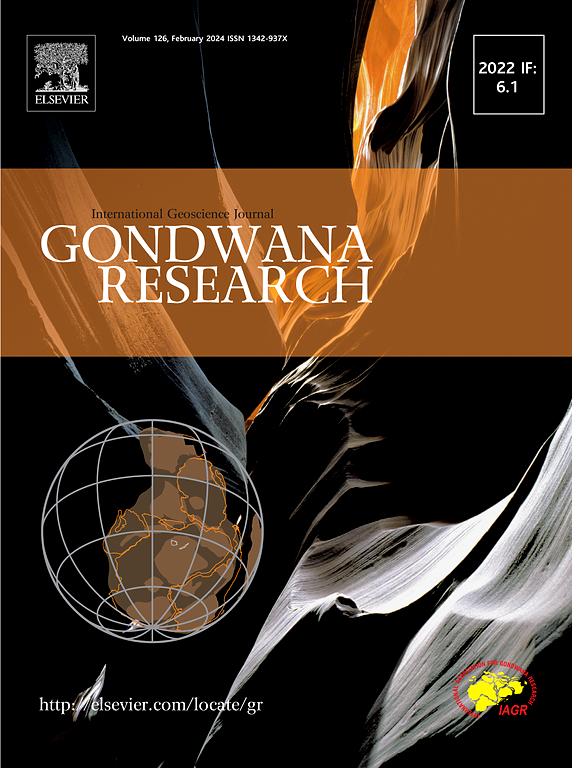Transcrustal magmatic systems in NE China: Insights from Early Cretaceous metaluminous–peraluminous–peralkaline rock associations in the southern Great Xing’an Range
IF 7.2
1区 地球科学
Q1 GEOSCIENCES, MULTIDISCIPLINARY
引用次数: 0
Abstract
The generation and evolution of crustal-scale magmatic systems are important in revealing the continental crust differentiation. In the Bayangeer-Aliwula area of Inner Mongolia, metaluminous–peraluminous–peralkaline rock assemblages provide a rare opportunity to evaluate Early Cretaceous magmatic systems. This study presents new geochemical data, including whole-rock and zircon geochemistry, zircon U–Pb dating, and Hf–O isotopic analysis of rocks formed between 132 and 121 Ma. The metaluminous rocks exhibit low SiO2 (55.35–65.65 wt%), low Rb/Sr (0.08–0.24) and (La/Yb)N (4.88–7.58) ratios, and positive εHf(t) values (+4.9 to +8.7). These features, along with enrichment in large-ion lithophile elements and depletion in Nb and Ta, suggest formation via partial melting of fluid-metasomatised lithospheric mantle. By contrast, peraluminous rocks have high SiO2 (69.37–80.58 wt%), a high differentiation index (DI = 88–95), and Fe-index (0.84–0.95), resembling highly fractionated I-type granites. They show high Rb/Sr (0.77–3.35) and (La/Yb)N (5.79–22.75) ratios, and positive εHf(t) values (+6.7 to +10.8), combined with the modelling results, indicating origin from partial melting of K-rich mafic lower crust followed by magma fractionation. Peralkaline rocks display typical ferroan A-type granite characteristics (Zr + Nb + Ce + Y = 906–4292 ppm; Fe-index = 0.96–0.99), with high SiO2 (74.02–77.50 wt%), high Rb/Sr (6.17–121.38), and (La/Yb)N ratios (2.19–17.72), and positive εHf(t) values (+3.1 to +9.6). Zircon geochemistry characteristics suggest that peralkaline and peraluminous felsic melts are different batches extracted from the same magma reservoir. Further analysis, including hyperbola diagrams and zircon oxygen isotope compositions, suggests peralkaline magma formation through the mixing of altered oceanic crust fluids and peraluminous melts after melt extraction. During Early Cretaceous, the transcrustal magmatic system provides a reasonable explanation for the petrogenesis of various contemporaneous rocks in the study area in southern Great Xing’an Range.

中国东北地区的跨地壳岩浆系统:大兴安岭南部早白垩世金属铝质-高铝质-过碱性岩关联的启示
地壳尺度岩浆系统的生成和演化对揭示大陆地壳分异具有重要意义。在内蒙古巴彦格尔-阿力乌拉地区,金属铝-高铝-过碱岩石组合为评价早白垩世岩浆系统提供了难得的机会。本研究提供了新的地球化学数据,包括全岩地球化学和锆石地球化学、锆石U-Pb年代测定以及对132至121 Ma期间形成的岩石进行的Hf-O同位素分析。金属铝质岩石表现出低SiO2(55.35-65.65 wt%)、低Rb/Sr(0.08-0.24)和(La/Yb)N(4.88-7.58)比值,以及正εHf(t)值(+4.9至+8.7)。这些特征,以及大离子亲岩元素的富集和Nb、Ta的贫化,表明岩石是通过流体-熔岩化岩石圈地幔的部分熔融形成的。相比之下,过铝质岩石具有较高的二氧化硅含量(69.37-80.58 wt%)、较高的分化指数(DI = 88-95)和铁指数(0.84-0.95),类似于高度分化的I型花岗岩。它们显示了较高的Rb/Sr(0.77-3.35)和(La/Yb)N(5.79-22.75)比值,以及正的εHf(t)值(+6.7至+10.8),结合模拟结果,表明它们起源于富含K的岩浆下壳的部分熔融,然后是岩浆分馏。围岩显示出典型的铁质A型花岗岩特征(Zr + Nb + Ce + Y = 906-4292 ppm;Fe-指数 = 0.96-0.99),具有高SiO2(74.02-77.50 wt%)、高Rb/Sr(6.17-121.38)和(La/Yb)N比(2.19-17.72),以及正εHf(t)值(+3.1至+9.6)。锆石地球化学特征表明,碱性长石熔体和高铝长石熔体是从同一岩浆储层中提取的不同批次的熔体。包括双曲线图和锆石氧同位素组成在内的进一步分析表明,碱性岩浆是在熔体萃取后通过改变洋壳流体和高铝熔体的混合形成的。在早白垩世,跨地壳岩浆系统为大兴安岭南部研究区各种同期岩石的岩石成因提供了合理的解释。
本文章由计算机程序翻译,如有差异,请以英文原文为准。
求助全文
约1分钟内获得全文
求助全文
来源期刊

Gondwana Research
地学-地球科学综合
CiteScore
12.90
自引率
6.60%
发文量
298
审稿时长
65 days
期刊介绍:
Gondwana Research (GR) is an International Journal aimed to promote high quality research publications on all topics related to solid Earth, particularly with reference to the origin and evolution of continents, continental assemblies and their resources. GR is an "all earth science" journal with no restrictions on geological time, terrane or theme and covers a wide spectrum of topics in geosciences such as geology, geomorphology, palaeontology, structure, petrology, geochemistry, stable isotopes, geochronology, economic geology, exploration geology, engineering geology, geophysics, and environmental geology among other themes, and provides an appropriate forum to integrate studies from different disciplines and different terrains. In addition to regular articles and thematic issues, the journal invites high profile state-of-the-art reviews on thrust area topics for its column, ''GR FOCUS''. Focus articles include short biographies and photographs of the authors. Short articles (within ten printed pages) for rapid publication reporting important discoveries or innovative models of global interest will be considered under the category ''GR LETTERS''.
 求助内容:
求助内容: 应助结果提醒方式:
应助结果提醒方式:


